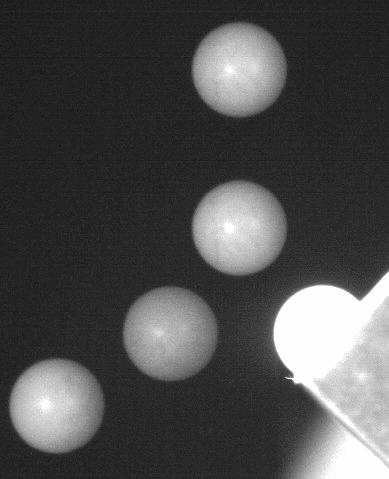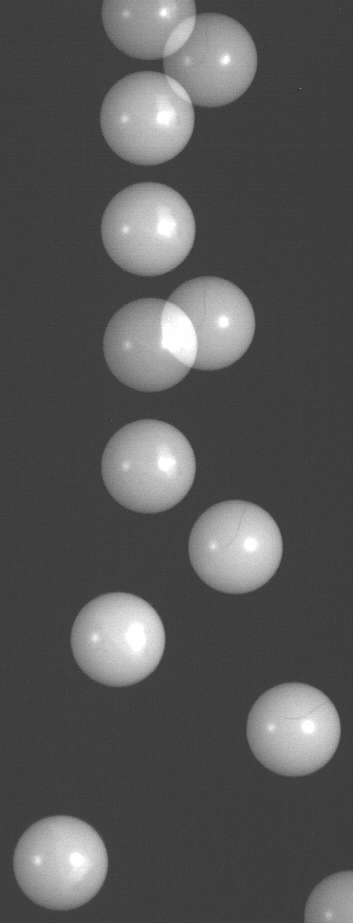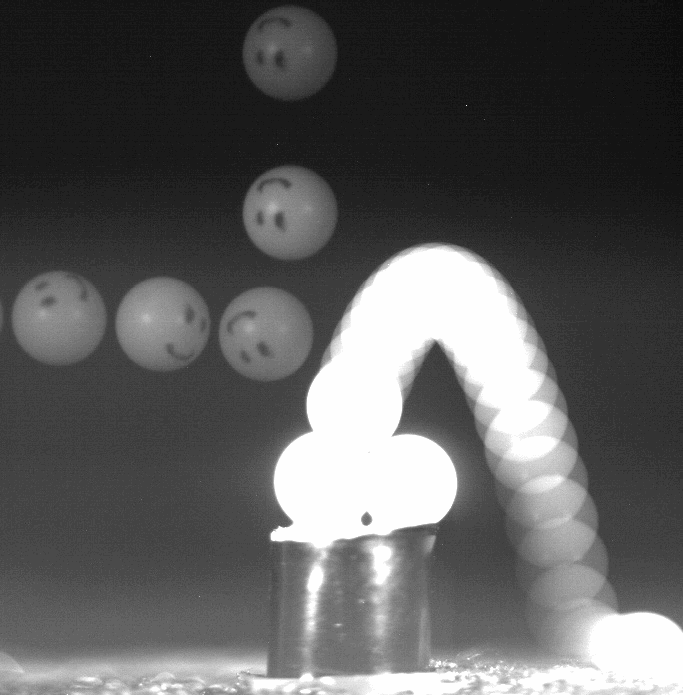Research on the impact of small spheres at Cornell
We developed at Cornell a unique facility to measure the behavior of small spheres upon impact. Unlike previous work involving impacts of a single sphere on a flat plate, our experiment can also evaluate the properties of binary collisions between two spheres. The apparatus releases the particles in a free-fall without initial spin. A digital camera captures a stroboscopic picture of the ballistic trajectories of the sphere before and after impact.
Impacts are modeled in terms of three coefficients proposed by Walton
(1988). The first is the
coefficient of normal restitution. The second is the coefficient of
friction for sliding impacts. The last is the coefficient of tangential
restitution for impacts that do not involve sliding. A table summarizes our results for a
variety of spheres.
Impact pictures
 Impact of a Delrin sphere on a glued spherical bump.
Impact of a Delrin sphere on a glued spherical bump.  Stroboscopic picture of the impact of two Delrin
spheres
Stroboscopic picture of the impact of two Delrin
spheres  Impact
of a Delrin sphere on a sphere glued on a three other spheres
Impact
of a Delrin sphere on a sphere glued on a three other spheres  Impact of a hard ceramic sphere on a softer lexan
plate
Impact of a hard ceramic sphere on a softer lexan
plate Results
Our main publications on this subject include:
S.F. Foerster, M.Y. Louge, H. Chang, and K. Allia: "Measurements of the collision properties of Small Spheres," Phys. Fluids 6, 1108-1115 (1994).
This paper outlines the design of our impact apparatus and the model
of Walton that is used to interpret the data. Greater detail is
available in Samuel Foerster's
thesis. Worksheets are used for data reduction of binary impacts and impact of a
sphere with a plate. A FORTRAN program incorporates
the theory of Maw, Barber and Fawcett for rolling versus sliding
impacts.
An excerpt of Foerster, Louge, Chang and Allia is
available here.
Michel Y. Louge, Christopher Tuozzolo and Adam Lorenz: "On binary impacts of small liquid-filled shells," Phys. Fluids 9, 3670-3677 (1997).
In this paper, we consider impacts of vitamin-E pills, which behave
a a liquid-filled shell. These particles were used in Eichi Fukushima's
MRI experiment in a rotating drum. Binary impacts are so brief that
only the pill's outer shell is set in motion. As the pill flies away
from impact, liquid viscosity gradually transfers rotation inward, thus
letting the particles "remember" the impact. The process is equivalent
to letting the sphere's moment of inertia vary with time.
An excerpt of Louge, Tuozzolo and Lorenz is
available here. Zipped source codes used in this paper are available here.
A. Lorenz, C. Tuozzolo and M.Y. Louge: "Measurements of impact properties of small, nearly spherical particles," Experimental Mechanics 37, 292-298 (1997).
In this paper, we report a technique to measure impact properties of
binary collision of nearly spherical particles, as well as impacts on
spherical bumps. We also discuss how the concept of kinematic
restitution can fail. A simple
calculation involving non-colinear impacts shows how the assumption
of a constant kinematic coefficient of normal restitution can lead to
absurd predictions.
An excerpt of Lorenz, Tuozzolo and Louge is
available here.
M.Y. Louge and M.E. Adams: "Anomalous behavior of normal kinematic restitution in the oblique impacts of a hard sphere on an elasto-plastic plate," Phys. Rev. E 65, 021303 (2002).
When hard spheres impact a softer plate at an oblique angle, the
energy stored in the tangential motion can be transferred to the
plate's normal direction, perhaps as the spheres plows in the softer
plate. This results in a coefficient of restitution that exceeds
unity. In fact, unless impacts are head-on, kinematic restitution can
be any positive number.
A version of Louge and Adams is available
here.
C.M. Sorace, M.Y. Louge, M.D. Crozier, and V.H.C. Law: High apparent adhesion energy in the breakdown of normal restitution for binary impacts of small spheres at low speed, Mechanics Research Communications 36, 364–368 (2009).
In this work, we used a pendular setup to create impacts of
millimetric spheres at low velocities. To our surprise, we found that
the apparent adhesion surface energy of two colliding spheres is much
larger than the corresponding energies measured in quasi-static
experiments. This causes normal restitution to breakdown at a critical
impact speed higher than previously thought or, equivalently, that the
breakdown of restitution arises for spheres much larger than expected.
We suspect that, in the loading phase of impact, asperities are crushed
and weld; in the unloading phase, higher energies are needed to
separate the fused material, perhaps explaining the apparent high
adhesion energy.
A manuscript version of Sorace, Louge, Crozier and Law is available here. You can download a Mathematica notebook implementing the viscoelastic impact theory of Brilliantov, Albers, Spahn and Poschel (2007), the data that it generates in Excel, and a Matlab optimization program to interpret our experimental results. However, as this Mathematica notebook indicates, because Brilliantov, et al treated their impact slightly differently than the JKR theory, we modified their theory for consistency with JKR.
Conference papers
Michel Louge and Michael Adams: "Impacts on a stationary tetrahedral array of spheres,"2eme Atelier International « Formation et Migration des Dunes », Nouakchott, 7-13 février 2001, Ahmed Ould el Moctar, ed. (2001).
This paper provides original information on binary impacts of Delrin spheres of different sizes, as well as impacts of Delrin spheres with arrays of stationary Delrin spheres.
Lorenz A. and Louge M.Y.: “Measurements of the collision properties of small spheres”, Proceedings of the First Meeting of the Particle Technology Forum, Denver, CO, August 1994.
This paper provides information on binary impacts of small polystyrene, acrylic and stainless steel spheres.
Further information
Download here two short papers summarizing integral relations between normal stress and displacement for arbitrary axi-symmetric loading of an elastic solid, and calculating the escape speed for two spheres subject to van der Waals attraction.
